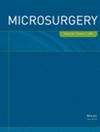Optimizing donor fascicle selection in Oberlin's procedure: A retrospective review of anatomical variability using intraoperative neuromonitoring
Abstract
Background
Transfer of the fascicle carrying the flexor carpi ulnaris (FCU) branch of the ulnar nerve (UN) to the biceps/brachialis muscle branch of the musculocutaneous nerve (Oberlin's procedure), is a mainstay technique for elbow flexion restoration in patients with upper brachial plexus injury. Despite its widespread use, there are few studies regarding the anatomic location of the donor fascicle for Oberlin's procedure. Our report aims to analyze the anatomical variability of this fascicle within the UN, while obtaining quantifiable, objective data with intraoperative neuromonitoring (IONM) for donor fascicle selection.
Methods
We performed a retrospective review of patients at our institution who underwent an Oberlin's procedure from September 2019 to July 2023. We used IONM for donor fascicle selection (greatest FCU muscle and least intrinsic hand muscle activation). We prospectively obtained demographic and electrophysiological data, as well as anatomical location of donor fascicles and post-surgical morbidities. Surgeon's perception of FCU/intrinsic muscle contraction was compared to objective muscle amplitude during IONM.
Results
Eight patients were included, with a mean age of 30.5 years and an injury-to-surgery interval of 4 months. Donor fascicle was located anterior in two cases, posterior in two, radial in two and ulnar in two patients. Correlation between surgeon's perception and IONM findings were consistent in six (75%) cases. No long term motor or sensory deficits were registered.
Conclusions
Fascicle anatomy within the UN at the proximal arm is highly variable. The use of IONM can aid in optimizing donor fascicle selection for Oberlin's procedure.

 求助内容:
求助内容: 应助结果提醒方式:
应助结果提醒方式:


